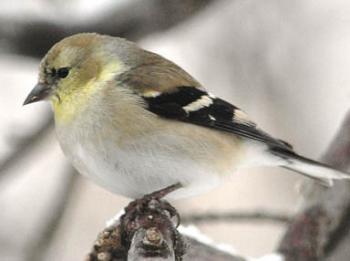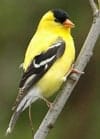Disappearing Act

Male American Goldfinch in Winter
Photo Credit: Jim Williams

Male American Goldfinch in Summer.
Photo Credit: Jim Williams
by Val Cunningham
Contributing Writer
“Where have all the goldfinches gone?” people ask, lamenting the absence of these bright, chipper little birds at feeders and birdbaths now that winter is looming.
The truth is that goldfinches haven’t gone anywhere — like Poe’s purloined letter, they’re hiding in plain sight.
They have three ways of coming in under our radar. For one thing, they now look completely different from their summer selves. The males have exchanged their bright yellow feathers and black head spot for a warm taupe-colored plumage, and now resemble summer females. Just about the only sign that these little brownish birds are goldfinches is the distinctive white striping on black wings.
Another way they seem to disappear is through a shifting sort of migration. “Our” adult birds do head south, to be replaced by adults from farther north who move southward. There may be short periods when a neighborhood does lack goldfinches, but it’s a void quickly filled by new arrivals. In truth, there are many more goldfinches around now, summer’s population boosted by all the youngsters who fledged at the end of summer. These young birds don’t migrate in their first year, but they do wander around like nomads, setting down where they can find food, moving from feeder to feeder and neighborhood to neighborhood.
And finally, goldfinches are fiends for wild seed and may have temporarily abandoned feeding stations to feast on the wild seed crop wherever flower heads still stand. Autumn must be this bird’s favorite season: unlike most other songbirds, who consume large numbers of insects, goldfinches live on a nearly unvarying diet of seeds, seeds and more seeds. And fall is nature’s seediest season, with an abundant buffet in gardens and parks all over our area.
Finches flock to nodding heads of sunflower, black-eyed Susan, monarda, liatris, aster, sedum, Joe-pye Weed, coreopsis, and an apparent favorite, the several varieties of coneflower. They visit birch and cedar trees for seeds, as well. They’re not picky, just about any seed will do—they even gather at the gnarly heads of burdock thistle found along woodland edges and shorelines. Listen to a small group of finches sitting in a treetop and they literally seem to be calling, “SEE-eeed.”
They’ll hover briefly in front of a likely looking plant, then land on a stalk or twig and slide toward the seed source. They’re very agile little birds whose strong legs allow them to even cling upside down, if necessary, to extract high-energy treats. Their sharp beaks easily break open the outer shell, and then they swallow the nutmeat inside.
My neighborhood’s large public raingarden, installed by the city and the local watershed district, is a major goldfinch magnet. A passerby may scare up 20 to 30 chattering little birds from the large clumps of native plants at this popular feasting site.
Any day now, most of the area’s flower stalks will sport denuded seed heads. That’s when you’ll begin to see small, light-brown birds at the feeders, snapping up nyger, sunflower or safflower seed, and then heading to the birdbath for a drink (seed-eating is thirsty business). Look closely and you’ll see just a hint of yellow, and you’ll know that your goldfinches have “returned.”
St. Paul, Minnesota resident Val Cunningham, leads bird hikes for the St. Paul Audubon Society and writes about nature for local, regional and national newspapers and magazines.



